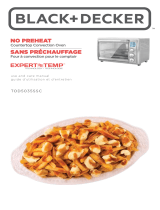Page is loading ...

Installing Clipper® Fasteners with
the Roller Lacer® Gold Class™
1. Square belt end off centerline. 2. Select the proper size hook for your
application.
3. If belt has an impression cover, skive back
1" (25mm) from the belt end.
1. Loosen hex screw to allow Face Strip
Retaining Latch to rotate out of the way.
Insert Face Strip, reposition Latch and
tighten screw.
2. The lacer head can be either manually
driven or power assisted with a cordless drill
(at least 18V power).
A. If manually driving head, use handle or
1/2" (13mm) socket and ratchet on top shaft to
index head to either end of tool.
B. if using a cordless drill, insert the
included 7/16" (11mm) nutdriver bit into the
cordless drill and place the nutdriver/drill
onto the back shaft. Set clutch to provide
minimal amount of torque necessary to embed
fasteners. Index head to either end of tool.
3. Turn knob clockwise to open rollers.
Prepare Lacer for Use:
Belt Preparation:
1. Face Strip Installation
A
B
C
5. If using hooks as shown in A or B, remove
carding paper at this time. If using hooks
as shown in C, remove carding paper after
installing hooks.
CONTINUOUS
LACING SLOTS
4. Insert hooks into the rst active slot of the
face strip. Secure with lacer pin.
FIRST ACTIVE SLOT
6. Lift Belt Support Shelf up and pull into
locked position.
HEX SCREW
LATCH
TOP SHAFT FOR
MANUAL DRIVE
BACK SHAFT
FOR POWER
ASSISTED DRIVE
TURN KNOB
CLOCKWISE TO
OPEN ROLLERS
BELT SUPPORT
SHELF
Patents: www.flexco.com/patents

Lacer Operation:
1. Guiding belt through clamp and over
belt support shelf, insert belt end into hook
points and ush against the entire width of
the face strip.
2. Lock belt clamp. 3. Position rollers over hooks.
4. Turn adjusting knob counter-clockwise
until rollers touch hooks.
6. Using cordless drill or manual override,
drive lacer head across the belt width at a low
to medium speed.
5. Return lacer head to end of lacer and turn
adjusting knob 1½ additional turns counter-
clockwise.
8. Remove lacer pin. Release belt clamp.
Remove belt from lacer.
NOTE: The belt will need to be ‘continuous
laced’ if it is wider than the lacer.
7. Turn adjusting knob counter-clockwise 1/2
turn and return head across the belt. Repeat
until hooks are embedded with 1/3 to 1/2 the
wire diameter into the belt.
• Wipe debris off chain-body extrusion periodically with a dry cloth to prolong the UHMW roller life.
• If head begins to rock back and forth on the extrusion after extended use, nger tighten adjusting screws
located on top and bottom of head.
Continuous Lacing Procedures:
1. Starting on one side of the belt, lace the rst section using the ‘Lacer Operation’
instructions listed above.
2. Open rollers.
3. Insert hooks into face strip, starting with the rst active slot.
4. Insert lacer pin. Remove carding paper from hooks, if applicable.
5. Guiding belt through the belt clamp and over the belt shelf, position laced hooks
into the continuous lacing slots, directly next to the rst active slot. Keep belt ush
against the face strip. Clamp belt.
6. Lace this section using Steps 3-8 of the ‘Lacer Operation’ instructions.
Helpful Tip: When continuous lacing it is recommended to lace the shorter length
of belt rst and then continue with the longer section of belt. Example: when using
a 24" Roller Lacer to lace a 36" wide belt, lace the 12" section of belt rst and then
follow the process to continuous lace the remaining 24" of belt.
Maintenance:
Turn knob 1½ turns
counter-clockwise 1/2 to 1/3 of the wire
diamater should be em-
bedded into the belt.
CONTINUOUS
LACING SLOTS
FIRST ACTIVE SLOT
2525 Wisconsin Avenue • Downers Grove, IL 60515-4200 • USA
Tel: (800) 541-8028 • Fax: (630) 971-1180 • E-mail: info@flexco.com
Visit www.flexco.com for other Flexco locations and products.
©2021 Flexible Steel Lacing Company. 11/16/21. For reorder: X1451
/














